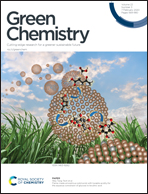A cytochrome c-urea functionalized dipeptide conjugate: an efficient HBD framework to synthesize 4H-pyrans via one-pot multicomponent reaction†
Abstract
This work is focused on the development of an efficient and green protocol for the one-pot multicomponent synthesis of a series of 4H-pyran derivatives. Herein, a protein–peptide conjugate (SS1–Cyt. c) is synthesized and characterized using Circular Dichroism (CD), UV-Visible absorption spectroscopy, and docking studies. The whole assembly is used as an efficient catalytic system by incorporating a derivatized dipeptide molecule in the hydrophobic cavities of the protein Cytochrome c (Cyt. c) that leads to the activation of Hydrogen Bond Donating (HBD) units of a urea derivative of a dipeptide (SS1). The HBD units tend to show non-covalent interactions with the reactant species responsible for triggering the occurrence of an organic transformation. Also, the stability and binding interactions of SS1–Cyt. c with the multicomponent reactants involved in the organic transformation are studied in detail using MD-simulation studies. It is a metal-free catalyst and provides higher yield in relatively short reaction times. As per green chemistry principles, the catalyst has provided us ideal Eco-scale and E factor scores of 79 and 0.089, respectively.



 Please wait while we load your content...
Please wait while we load your content...